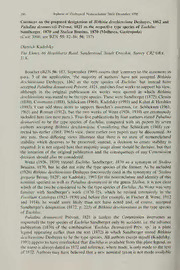
Comment On The Proposed Designation Of Bithinia Deschiensiana Deshayes, 1862 And Paludina Desmarestii Prevost, 1821 As The Respective Type Species Of Euchilus Sandberger, 1870 And Stalioa Brusina, 1870 PDF
Preview Comment On The Proposed Designation Of Bithinia Deschiensiana Deshayes, 1862 And Paludina Desmarestii Prevost, 1821 As The Respective Type Species Of Euchilus Sandberger, 1870 And Stalioa Brusina, 1870
266 Bulletin ofZoological Nomenclalure 56(4) December 1999 Comment on the proposed designation of Bithinia deschiensiarta Deshayes, 1862 and Paludina desmarestii Prevost. 1821 as the respective type species ofEuchilus Sandberger, 1870 and Stalioa Brusina, 1870 (Mollusca, Gastropoda) (Case 3008; see BZN 55: 82-86; 56: 187) Dietrich Kadolsky The Limes. 66 Heathhurst Road, Sanderstead. South Crovdoii, Swrev CR2 OBA. U.K. Bouchet (BZN 56: 187, September 1999) asserts that 'contrary to the statement in para. 3 of the application, 'the majority of authors' have not accepted Bithinia deschiensiana Deshayes, 1862 as the type species of Euchihts' but instead have accepted PahidinadesmarestiiPrevost, 1821,andcitesfourworkstosupporthisview, although in the original publication six works were quoted in which Bithinia deschiensianawasstatedtobethetypespecies.ThesewereSandberger(1872),Clessin (1880), Cossmann (1888). Schlickum (1968). Kadolsky (1993) and Kabat & Hershler (1993). I can add three more to support Bouchet's assertion, i.e. Schlickum (1961, 1965) and Roman (1912), but the two works ofWenz (1926, 1939) are erroneously included here(seenext para.). Thusfive publicationsby fourauthorsstated Paludina desmarestii to be the type species of Euchilus. compared with six papers by seven authors accepting Bithinia deschiensiana. Considering that Schlickum (1968) cor- rected his earlier (1961. 1965) view, these earlier two papers may be discounted. At any rate, these differing views illustrate that there is no state of nomenclatural stability which deserves to be preserved; instead, a decision to create stability is required. It is not argued here that majority usage alone should be decisive, but that the intention ofthe original publication and the consequences ofany Commission decision should also be considered. Wenz (1926, 1939) treated Euchilus Sandberger, 1870 as a synonym of Stalioa Brusina, 1870. but he did not state the type species of the former. As he included (1926) Bithiniadeschiensiatia Deshayes(incorrectly cited in the synonymy of'Stalioa gregaria Bronn, 1829"; see Kadolsky. 1993 for the nomenclature and identity ofthis nominal species) as well as Paludina desmarestii in the genus Stalioa, it is not clear which ofthe two heconsidered to be the type species ofEuchilus. AsWenzwas very familiar with Sandberger's work (1870-75), which he revised extensively in the Fcssilium Catalogus (1923-1930) and before (for example, in Fischer & Wenz, 1912 and 1914), he would more likely than not have noted and, of course, accepted Sandberger's designation (1872, p. 225) ofBithinia deschiensiana as the type species ofEuchilus. Paludina desmarestii Prevost, 1821 is (unless the Commission intervenes as requested) the type species ofEuchilus Sandberger only by accident, i.e. the advance publication (1870) of the combination 'Euchilus Desmarestii Prev. sp.' in a plate legend appearing earlier than the text (1872) in which Sandberger stated Bithinia deschiensiana Deshayes to be the type species. All authors except myself(Kadolsky, 1993) appear to have overlooked that Euchilus is available from this plate legend, as thename isalwaysdated as 1872 and reference, wheremade, isonlymadeto thetext of 1872. Authors may have believed that a new nominal taxon is not madeavailable Bulletin ofZoological Nomenclature 56(4) December 1999 267 by publication in a plate legend alone. Under the premise which these authors accepted, that the name Euchilus was only made available in the text, Bithinia deschiensiana Deshayes would become the type species by original designation and the subsequent designation of Paludina desmarestii Prevost would be plainly erroneous. None of the authors who believed the latter to be the type species of Euchilus gave any reasoning for this view, but an oversight is the most likely explanation. The main reason for Sandberger to introduce the new genus Euchilus was the presenceofa calcareous, concentricallystructured operculum. Thiswasdescribedby Deshayes (1862) only for Bithiniadeschiensiana. Sandberger merely assumed it to be present in the other species which he included in Euchilus. Thus, the intended type species is the only one which actually shows the principal diagnostic feature ofthe genus. (It may be doubtful whether this operculum does belong to Bithinia deschiensiana, but in this context only the intention ofSandberger is relevant). No valid reason has been given by Bouchet to support his wish to secure the synonymy ofStalioa and Euchilus by making them objective synonyms, contrary to Sandberger"s intention andcontrary to subsequent usage by the majority ofauthors. Ifthe two candidate type species of Euchilus were congeneric, Euchilus and Stalioa would become subjective synonyms, without the need for any action by the Commission; in this case I would prefer that Stalioa should have precedence over Euchilus, astheexact dates ofpublicationwithin 1870 ofboth namesarenot known. However, I (Kadolsky, 1993) demonstrated that the relationship between Paludina desmarestiiand Bithiniadeschiensianaisveryremote, and that no genericnameother than Euchilus can be considered for use for a genus which includes Bithinia deschiensiana. I refrained from introducing a new name because ofthe existence of EuchilusSandberger, 1870,expectingthat the Commissionwouldvalidateitwith the originally intended type species. If Paludina desmarestii were to become the type species of Euchilus. a new generic name would have to be introduced for Euchilus sensu Kadolsky (1993), based on the current assessment ofthe taxonomy. In thecaseofStolira Fuchs, 1877, 1 wouldagreethat thereisgenerallyno needfor the Commission to suppress erroneous spellings but it should be possible to make exceptions in order to avoid ambiguity and doubt. Fuchs twice spelt the name "Stoliva', and suppression would remove the technical possibility of accepting this spelling as an intentional introduction ofa new nominal genus. In summary, the original proposals and theirjustification are maintained. Additional references Fischer, K. & Wcnz, W. 1912. Verzeichnis und Revision der tertiaren Land-und Siisswasser- gastropoden des Mainzer Beckens. Neiies Jahrhuch fiir Mineratogie. Geologic und Palaeonlolugie. Beilagenband 34: 431-512. Fischer,K.& Wenz,W. 1914. Die LandschneckenkalkedesMainzerBeckensundihre Fauna. Jahrbuch desnassauischen Vereinsfiir Nalurkiinde. 67: 21-154.
